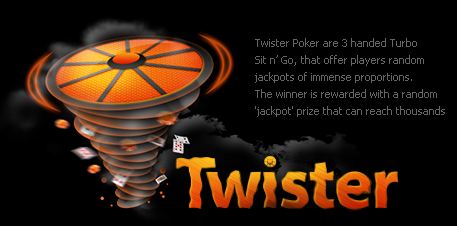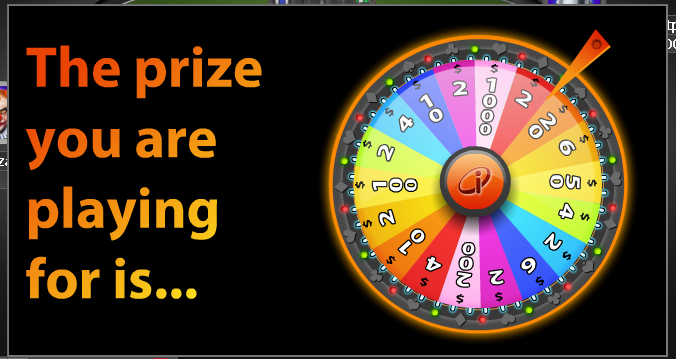Twister Sit N Goes Are Fun, Fast And Very Beatable
Over the last few days I have clocked up almost 100 Twister Sit N Goes. While this is too small a sample to tell whether I am a long-term winner in these games, it has given me plenty of time to think about the strategy.
This article is a guide for recreational and amateur players on how to approach the twisters. My insights will keep you from making mistakes which incrementally cost you money. At the same time you will learn what to look out for in your opponents play and how to take advantage of the weaknesses you find.
First up, for those new to this game, here is an overview of how they work. After that the strategy part.
Planet Mark’s Rec: The Easiest Sit and Goes Online are Over at America’s Cardroom!
You can use them to grow a bankroll, qualify for online tournaments, or even to help you win a seat in the World Series.
Instead of tables full of ‘regulars’ who know the math, bubble strategy and hand ranges, ACR Poker is recreational. Compare the fields to the bigger sites, and you will quickly see how soft they are for yourself.
You can get your bankroll off to a flying start with a 100% matched bonus using referral code: SNGPLANET
Check out the latest promos and tournament events for yourself now, over at www.americascardroom.eu!
Twister Sit N Goes – Game Overview
Twisters are 3 handed super-turbo tournaments, you’ll start with 500 chips and the blinds will go up every 2 minutes. Games last about 10 minutes on average and you can choose between buy-ins of $1, $2, $5 or $10. The winner of each game takes the prize.
What is new with these Sit N Goes is that the prizes are randomized, and can be up to 1000 times your buy-in.
When a new game starts a ‘Wheel Of Fortune’ type wheel spins, and where it stops is the prize you are playing for in that particular game. In order to build the jackpots for the bigger payouts, most of the games are paid at double the buy-in. You can get lucky and hit a 10x, 20x, 100x or even the big on at 1000 times your buy-in. The best I have done so far is a 10x, though I did win that game!
You can select up to 6 games at any buy-in level, and do not see the other players until the games kick off. These are very popular games and I have yet to see the same player more than twice after 100 games.
Twister Sit N Goes – Strategy For These Games
3 things to cover here: The fast blinds, the bad players and the effect of the prize pool.
Fast Blinds:
These games are fast, here are the blind and ante schedule with the increases happening every 2 minutes.
10/20
15/30 ante 5
20/40 ante 5
30/60 ante 5
40/80 ante 8
50/100 ante 10
60/120 ante 10
80/160 ante 15
If you wait for a good hand, you’ll simply blind away, after all you will be paying one of the blinds 2 out of 3 hands.
This means that your starting hand requirements need to go way down. The exact hands you select will depend on your opponents and the depth of your stack at that point (you choose different hands for 10 big blind chip stacks than 20+ BB stacks). Any ace is a monster in an unraised pot, most kings are playable and any 2 cards above 9 will do under most circumstances.
When someone raises ahead of you then you can be more selective, especially in the first 2 levels. I have seen so many people wait for hands only to find themselves short stacked and desperate in these games… Please, pick a hand and fight for the pot early to avoid this happening to you.
Heads-up the small blind acts last after the flop, with antes in play you are getting more than 3-to-1 to at least complete. Sure, you can fold the weakest hand, but walking the big blind heads up more than a couple of times in one of these games means you are making a mistake. For background reading and more situations in fast blind games, you can check out my strategy guide for Super / Hyper-Turbo Sit n Goes.
Shallow Stacks:
 There are a lot of pot-odds mistakes at the Twister SNG tables. Here is a classic example:
There are a lot of pot-odds mistakes at the Twister SNG tables. Here is a classic example:
With effective stacks of 8 times the big blind, the button raises 2x, the small blind folds and the big blind pushes all-in… causing the initial raiser on the button to fold.
Here are the numbers with 480 chips each at 60 / 30 blinds.
Initial raise: 120
Blinds + Ante in pot: 105
Reraise: 415 more in addition to 65 in blind + ante already posted
Total in pot: 640
Total to call: 355 (the button paid an ante pre-flop)
This is odds of over 1.8 to 1, this means that winning this pot just 39% of the time would make this a mathematical call. When you think of how wide a range of hands the big blind might be re-raising with, 39% is usually plenty enough. For example, even K7s has 40% equity against a range which includes any ace and other high-card combinations as well as all pairs.
While it can feel like you are being cautious or sensible here, these folds cost you money over time. If you have the right odds to call, then you must call.
Of course, you should take this kind of scenario into account before you play. Pushing all-in with 10BB or lower stacks works great, and will get folds from many hands which might have forced you into a coin-flip. If you know someone will try and ‘re-steal’ your raises, then you can often find spots to induce a raise if you do get a relatively strong hand. For more on this concept and why you should not usually raise-fold with a stack of under 10 times the big blind see this article introducing push-fold strategy;
Crazy Opponents:
 Opponents fall into 3 broad categories. There are the aggressive types who shove a lot and are raising most of the time (a great strategy when used intelligently). There are also a lot of players who are way too passive, calling, completing the blinds and checking the flop even when they hit a part of it. Third there are a few better balanced players who will stab at pots, raise their weaker / more passive opponents and shove correctly.
Opponents fall into 3 broad categories. There are the aggressive types who shove a lot and are raising most of the time (a great strategy when used intelligently). There are also a lot of players who are way too passive, calling, completing the blinds and checking the flop even when they hit a part of it. Third there are a few better balanced players who will stab at pots, raise their weaker / more passive opponents and shove correctly.
Shove-Happy Types: One all-in pre-flop may be with a monster (a common play), if you see several shoves the chances are that this player is just taking advantage if their opponents fear of busting. I recommend you spend some time with an odds calculator here. Start with a 50% shoving range and see what type of hands have a positive expectation when calling. Remember that the blinds will give your call a natural overlay.
Aggressive Types: People who raise almost every hand often win a lot of chips against the passive opponents. They also set themselves up for resteals, which can be very profitable. The worst thing you can do with fairly good hands is to call, you’ll miss most of the time and likely face a bet on the flop. Of course, calling / slowplaying works great when you have a monster!
Passive Types: In my experience in the Twisters, most opponents are too passive. They fold too much, call when they should not, raise-fold too often and generally do not understand how different relative hand strengths are in this game. If you can find someone who regularly folds to a small raise, then keep on raising until they play back. Everyone needs to balance their play and fold sometimes. If you find yourself short too often then you could be in this category without realizing it. My advice is clear – go to war with any 2-cards before you get so short that you can’t make your opponents fold. If you are the raiser, then that is even better.
Factors Affecting Twister Sit N Go Strategy #3 – The Prize Pool
Lets face it, a lot of people having fun in these games are not bothered by a $2 or $4 prize. When the prizes start to get bigger, many small stakes players get flustered and go into extra-passive mode.
I have not yet had a 100x or 1000x prize, so this thought comes from playing the bigger Steps Sit N Goes.
My expectation is that big prizes will seriously affect people who are used to tiny stakes games. They will not want to make any mistakes, and in trying hard they will make more. The most likely mistake is going too passive / tight. I’m going to keep playing so I can put this theory to the test, but when you get a $1000+ prize pool, raising and continuation betting has to be the best strategy.



